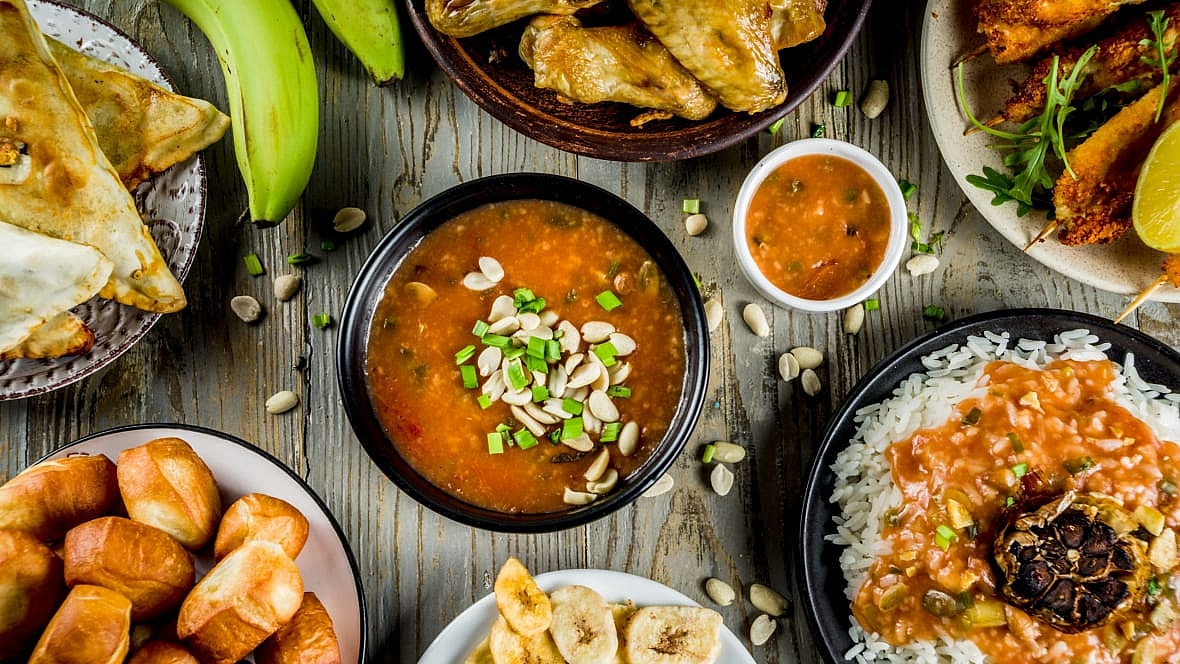Food is food, no matter where you go.
That’s the message from two chefs with African roots educating Americans on cuisine few know much about but likely isn’t so different from what they’re used to.
“My biggest mission really is to introduce people to the food,” Chef Kuukua Dzigbordi Yomekpe told theGrio.” [African food is] very diverse, just like the U.S. cuisine is diverse.”
Another chef, Evi Aki, told theGrio, “For me, I’m opening them into the world of African cuisine.”

Aki’s a food blogger and caterer whose cookbook, Flavors of Africa, contains recipes from her Nigerian heritage and other regions of the continent. The first-generation American lives in the Los Angeles area.
Kuukua — she prefers her first name — founded Asempe Kitchen, a Central New York business based in the Finger Lakes region that promotes mostly plant-based foods from Ghana through pop-ups, catering, and cooking classes.
Africa has five regions — northern, western, eastern, central, and southern — each with its unique flavors. Nigeria and Ghana sit in the western region, with cuisine that uses rice, peas, green vegetables, goat, beef, and chicken, among other items.
People often associate African food with Ethiopian cuisine since Ethiopian restaurants tend to be more established and have a solid footprint, with about 350 restaurants in the United States, according to one estimate.
Ethiopia, in the Horn of Africa in the northeast, relies on grains and vegetables for its meals, in addition to various types of meat. Classic dishes include legume stew (Shiro be Kibbe), lentil salad (Azifa), and the famed chicken thigh stew known as Doro Wat.
Even within West Africa, the cuisine has differences, though the ingredients are consistent. “We cook with a lot of starchy foods and vegetables since that’s what’s around the region,” Aki said. “Yams, rice, leafy green vegetables; that’s mostly what West African food is known for.”
Naturally, West African cuisine shares similarities with Caribbean dishes since enslaved people brought their food and their culture to the islands. Aki’s Instagram page and recipes illustrate the relationships between the two.
For example, her fusion dish, Creole Shrimp Mofongo, contains flavors from Puerto Rico, where Mofongo (a dish based on smashed plantains) is a staple. She also makes beef patties, which are similar to the patties and empanadas of the Caribbean, and sweet plantains known as Maduros across the Caribbean.
“I like to explain it as the transatlantic slave trade,” said Aki. “That’s pretty much how we get to where we are with food today, and [why] it’s so similar. It’s just the different preparations that it goes through. Typically, that’s based on what was available.”
Kuukua’s plant-based approach features dishes like Nkatsi Nkwan, a peanut soup, and Egusi, a leafy green and ground seed stew also known as Kontomire Froyi. She also makes meals with meat, if asked.
With its basmati rice, curry, and satay, Kuukua’s cooking style is reminiscent of Indian cuisine.
“If you’ve had Indian food, the peanut soup and stew is kind of like a Panang curry or a Massaman curry. I can bring the cuisine back to something they know,” she said.
Kuukua is working on a culinary memoir, a collection of stories and essays around food, growing up in Ghana, and immigrating to the United States.
“I think it’s the one thing that unifies humanity, is everybody must eat something to continue living,” she noted. “If it’s mashed or if it’s pureed or if it’s become liquid, you’re still needing sustenance to continue to survive on Earth, right?”
However, she also approaches food as a unifying force that could use more of those efforts.
“I approach it that way — everybody must eat,” said Kuukua. “This is what I eat; I’m sharing it with you. What do you eat? Yes, I’ve had that. I like this. I like that. What do you like? Well, now that you’ve had this, what do you think? And some people will come back time after time.”
In that spirit, Chef Kuukua and Chef Evi Aki have each shared a signature recipe with theGrio.
Chef Kuukua Dzigbordi Yomekpe’s Egusi
Ingredients
2-16 oz. bags of frozen spinach
Two jumbo-sized onions
2 lbs of meat of choice (optional)
One box of broth of choice (optional)
One or more habanero or fresh chilies of choice
One 16oz can of tomato paste
Fresh ginger and garlic to flavor
Adobo to taste
Egusi/Agushie (melon seeds) (available at any African market)
Guidelines
PREP | 10-15 MIN
Rinse & Peel all onions, ginger, garlic
Chop garlic and ginger finely
Chop onions (cube size)
Rinse and cut meat
Season with adobo
MAIN AFFAIR PART 1 | 30 MIN
Put seasoned meat with chili in a pot with about 20oz of water
Bring to medium boil for about 20 min then reduce to low fire for 10 minutes
Drain broth into measuring cup for later use
Save chili for stew
MAIN AFFAIR PART 2 | 20 MIN
Pour in about a cup of oil and add your onions, garlic, and ginger and sauté until translucent
Stir in tomato paste or sauce
Stir in melon seeds and fry the entire sauce mixture for about 5 min
Stir in frozen spinach and add about 2-4 oz of broth
MAIN AFFAIR PART 3 | 30 MIN
Let the stew simmer for 20-30 minutes on low heat, stirring occasionally and adding bits of broth and oil if the stew is too thick
Serve with Eba, boiled potatoes, boiled plantains or rice.
*If you won’t consume the entire serving, divide and freeze in smaller containers.
Chef Evi Aki’s Jollof Rice
Ingredients
Five medium-sized Roma tomatoes, roughly chopped
One red bell pepper, roughly chopped
One medium-sized onion, roughly chopped; set aside
Two scotch bonnet peppers (or habanero peppers, as they are sometimes called)
1/4 cup of groundnut oil
3 tbsp tomato paste
2 cups of parboiled rice
2 1/2 cups of chicken stock
1 tsp salt to taste
1/2 tsp curry powder
1/2 tsp thyme
1 tsp all-purpose seasoning
One Knorr stock cube
Three bay leaves
Water, as needed
Instructions
Blend your tomatoes, red pepper, and scotch bonnet peppers in a food processor or blender for about 45 seconds, making sure everything is blended well.
In a medium-sized pot, heat your oil on medium-high heat. Once the oil is heated, add the onions you set aside and fry just until they turn golden brown. Once the onions have turned brown in color, add the tomato paste and fry for 2-3 minutes. Then, add the blended tomato mixture (reserve about 1/4 cup and set aside) and fry the mixture with the onions and tomato paste for about 30 minutes. Make sure you stir consistently, so the tomato mixture does not burn.
After 30 minutes, turn the heat to medium and add the chicken stock. Mix and add your seasonings (salt, curry powder, thyme, all-purpose seasoning, and the Knorr stock cube). Continue to boil for 10 minutes.
Add the parboiled rice to the pot. Mix it very well with the tomato stew. At this point, if you need to add water so that the rice is level with the tomato mixture/chicken stock, go ahead and do so. Add the bay leaves, cover the pot, and cook on medium to low heat for 15-30 minutes.
When the liquid has almost dried up, add the remaining tomato stew, cover, and let it cook for another 5-10 minutes heat until the liquid has completely dried up. Turn off the heat, mix thoroughly, and your Jollof rice is ready to be eaten!

Ray Marcano is a veteran journalist who loves to cook and write about food. He’s the former national president of the Society of Professional Journalists, a two-time Pulitzer juror, and a Fulbright Fellow.
TheGrio is FREE on your TV via Apple TV, Amazon Fire, Roku, and Android TV. TheGrio’s Black Podcast Network is free too. Download theGrio mobile apps today! Listen to ‘Writing Black‘ with Maiysha Kai.

